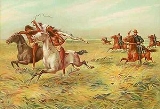
to describe a series of conflicts between American settlers or the federal government and the native peoples of North America
before and after the American Revolutionary War
. The wars resulted from the arrival of European colonizers who continuously sought to expand their territory, pushing the indigenous populations westwards. The wars were spurred by ideologies such as Manifest Destiny
, which held that the United States
was destined to expand from coast to coast on the American continent, and which resulted in the policy of Indian removal
, by which indigenous peoples were removed from the areas where Europeans were settling, either forcefully or by means of voluntary exchange of territory through treaties.
Today Native Americans make up 1.37% of the population of the United States.
1763 Indian Wars: Pontiac's Rebellion begins – Chief Pontiac begins the "Conspiracy of Pontiac" by attacking British forces at Fort Detroit.
1814 Indian Wars: the Creek sign the Treaty of Fort Jackson, giving up huge parts of Alabama and Georgia.
1832 Indian Wars: The Black Hawk War begins – the Sauk warrior Black Hawk begins a war with the United States.
1842 Indian Wars: Second Seminole War ends, with the Seminoles forced from Florida to Oklahoma.
1855 Indian Wars: in Nebraska, 700 soldiers under United States General William S. Harney avenge the Grattan Massacre by attacking a Sioux village and killing 100 between men, women and children.
1862 Indian Wars: The Dakota War of 1862 begins in Minnesota as Lakota warriors attack white settlements along the Minnesota River.
1862 Indian Wars: during an uprising in Minnesota, Lakota warriors decide not to attack heavily-defended Fort Ridgely and instead turn to the settlement of New Ulm, killing white settlers along the way.
1862 Indian Wars: In Minnesota, 303 Dakota warriors are found guilty of rape and murder of whites and are sentenced to hang. 38 are ultimately executed and the others reprieved.
1863 Indian Wars: Chief Pocatello of the Shoshone tribe signs the Treaty of Box Elder, agreeing to stop the harassment of emigrant trails in southern Idaho and northern Utah.
1864 Indian Wars: Indian Wars: Indian Wars: [[Sand Creek Massacre

